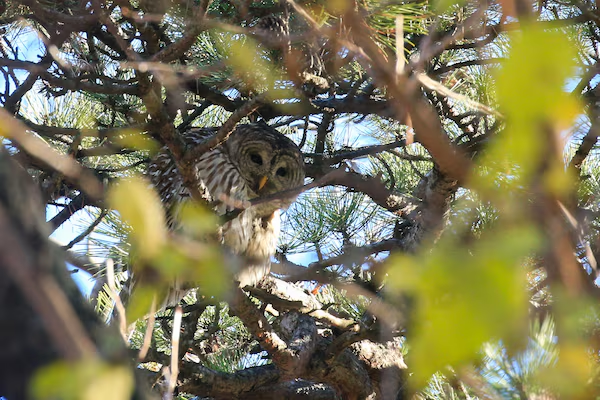For 12 weeks this summer, a quiet neighbourhood in Vancouver became the unlikely stage for a wildlife pilgrimage. No distant travels, no grand plans—just a simple daily walk to see a family of barred owls nesting nearby.
The journey began unexpectedly in a front garden, where a barred owl named Benny caught attention. Perched halfway up a pine tree, Benny appeared peaceful and still, basking in the sunlight. This unusual closeness to humans drew curious neighbours, who soon gathered regularly to admire the striking bird.
Benny was not alone. His mate, Bernadette, had made her home in a large hollow of an old willow tree in Douglas Park. From the ground, residents and visitors could easily watch the nest and speculate about its occupants. Were there eggs? Perhaps even baby owls?
At dusk, Bernadette’s hoots were different from Benny’s—a raspier, more urgent call. She flew between branches, demanding food from her partner and signaling the start of active nest life.
Soon, bird watchers joined the daily crowd. Some were seasoned photographers, camouflaged and patient, waiting for the perfect shot. One woman even spent six hours watching the tree, hoping to capture the elusive family.
The arrival of the owls did not go unnoticed by other local wildlife. A nearby squirrel family seemed wary, but it was the crows that made the most noise. They relentlessly mobbed Benny, diving and pecking at him in aggressive attempts to claim the tree. Yet Benny remained calm and steadfast, undeterred by their hostile presence.
Recognizing the owls’ importance, the city installed protective fencing around the tree and posted signs urging visitors to keep quiet as the owls nested. While people weren’t always silent, their main focus was the arrival of the owlets.
When the baby owls finally appeared, the neighbourhood buzzed with excitement. Locals exchanged stories like old friends at a community gathering, sharing photos and sightings. One woman recalled Benny flying overhead with a large rat in his talons—proof of the owl’s skilled hunting.
For many, the barred owls became more than just birds—they were a reason to connect. Neighbours who normally exchanged few words now stopped to help each other spot the owls in the trees. Drivers and cyclists slowed down, curious about the crowd gazing upwards. “Owls” became a familiar word, uttered with shared joy and wonder.
Two owlets lived in the nest. The first, playfully named Albertine, showed signs of growth, learning to perch and explore. The second, Paloma, was a bit more cautious but equally endearing. The evening before they left the nest, photographers gathered in large numbers, eager to witness the fledging—a moment when young birds take their first flight.
Once out of the nest, the owlets climbed higher into the tree, vulnerable to crow attacks. To protect them, the adult owls positioned themselves strategically, swooping at crows to chase them away. The family’s struggle against these noisy rivals became a daily drama for observers.
As weeks passed, the owlets grew stronger, practicing flying and vocalizing with long whistles instead of hoots. The family began to explore nearby trees, slowly expanding their territory.
One day, after two months of daily visits, the owls disappeared from their usual spot. Fans worried but soon found the family had moved just a few blocks away. There, Albertine and Paloma continued to grow and play, still under the watchful eyes of Benny and Bernadette.
Though no longer a daily spectacle, the owls remain part of the neighbourhood’s life. The crowds have thinned, but small groups still gather to share sightings and stories.
This experience has offered something rare: a moment of escape and a reminder of life’s simple wonders. Watching the barred owls, people discovered a shared joy in nature and in each other, rekindling a sense of community that can be hard to find in city life.
The barred owls of Vancouver are not just birds; they are a living connection to the wild and a symbol of the beauty that can thrive right outside our doors.

